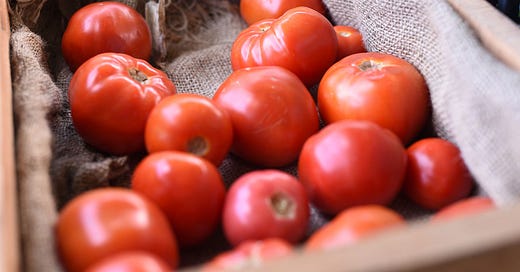23rd March, 2021. Tomatoes | Hoovering
The material weight of our tomato crops; sucking carbon out of the atmosphere.
Welcome to Just Two Things, which I try to write daily, five days a week. Some links may also appear on my blog from time to time. Links to the main articles are in cross-heads as well as the story.
#1: The material weight of tomatoes
(Image: Wikipedia)
The energy and environmental academic Vaclav Smil has had quite a lot of airplay here recently, but his recent analysis of the vast footprint of our tomatoes on the IEEE blog is unmissable.
The tomato is now the largest ‘vegetable’ crop on the planet, clocking in at 180 million metric tons a year, twice as much as onions, and five times as much as peppers. It’s not too hard to grow and it’s versatile to use. Grown in the garden, they take up relatively little energy. But most tomatoes are grown in greenhouses or tunnels, hydroponically, and that’s a whole different story:
Direct energy inputs include electricity, gasoline, and diesel fuel; indirect energy costs involve the production of fertilizer (particularly nitrogen), pesticides, fungicides, and plastics and metals (not only for covers but also for cultivation troughs and copious pipes and heaters).
The biggest concentration of tomato growing in the world is in Almeria, in southern Spain—you can see this from space. Most American tomatoes come from California, Minnesota, and New York. Once you start heating the tunnels, the environmental impact goes through the roof:
A 125-gram tomato of Almería that is grown in an unheated plastic tunnel requires about 150 kcal; one grown in heated structures, about 560 kcal. It provides about 22 kcal of food energy… the required storage, packing, and trucking to a regional distribution center raises the total energy cost to 460–875 kcal/125 g.
(Seen from space: the Almeria tomato industry. Source: NASA Jet Propulsion Laboratory)
In other words, an Ameria tomato gets through around 20 times as much energy as it provides, by the time it gets to the home; a heated greenhouse tomato around 40 times as much; and some European tomatoes are even less efficient than this. Smil asks us to imagine this energy input as if we are pouring tablespoonfuls of diesel fuel over our tomatoes, instead of an oil-and-vengar dressing, before we tuck in:
For a 125-gram tomato it would come to 10 tablespoons. For a family-size salad, requiring a kilogram of those regularly sized greenhouse tomatoes (cluster of eight, still attached to a strong green vine), you’d incur an energy production cost equivalent to 80 tablespoons, or 5 cups of diesel fuel.
Delicious.
#2: Sucking carbon out of the atmosphere
China Dialogue has an article about the possibility of simply sucking CO2 out of the atmosphere, and my first instinct was to disregard it as being, most likely, an excitable piece of science-techno-whizzery in which the writer gushes about an improbable technology that hasn’t even got to proof of concept stage in the lab and would take decades to get to use, if at all. But the writer was Fred Pearce, a former New Scientist editor who is one of the most credible science and environmental journalists on the planet, and so I went back and had a more careful look.
As Pearce says himself, “it sounds insane”.
But… the cost of such a system has been falling since the 1990s, and may be getting to levels where it is feasible. The article draws on research by Oscar Rueda at Leiden University that looks at the options for reducing emissions:
In a few decades… technologies known as direct carbon capture may be judged better for the atmosphere than putting parasols above the planet; more reliable than fertilising the oceans; and quicker and less demanding on land than planting a trillion trees. The vacuum cleaners could…be the least bad option.
The numbers go like this. The Royal Society in London has estimated that limiting warming to 1.5C would require capturing about 810 billion tonnes of CO2 by the end of the century – the equivalent of about 20 years of current emissions. There other estimates in both directions. There are no good options for this, but some are worse than others. Pearce works through them all in some detail in his article.
What has made the difference to the vacuuming idea now is that the price keeps coming down. Two years ago, it was estimated as being $232/tonne, including the costs of storage. Now it could be heading towards $100/tonne:
“There’s been very rapid progress,” said Stephen Pacala of Princeton University in a recent interview. “So much so that that knowledgeable people who are not starry eyed, but just hard headed, believe there is a high probability that a research effort within 10 years would produce direct air capture at $100 a tonne.”
Of course, that $100/tonne figure is similar to both the Royal Society’s estimate of a reasonable carbon price, and some of the figures currently floating around in business and political circles as a likely price for carbon by 2030.
After a thorough review of available NETs [negative emissions technologies], [Rueda] concluded that “DACCS [Direct Air Carbon Capture and Storage] emerges as the most attractive”. According to him, it is highly effective, highly feasible both technically and politically, has low side-effects provided there is plenty of renewable energy to power it, delivers permanent storage, and has the largest potential. Rueda suggests combining DACCS with reforesting and soil-carbon sequestration, both of which are cheap, available now and ecologically and agriculturally beneficial.
Of course, it would be better not to pump the emissions into the atmosphere at all. But it is pretty clear that that ship has already sailed.
j2t#062
If you are enjoying Just Two Things, please do send it on to a friend or colleague.




